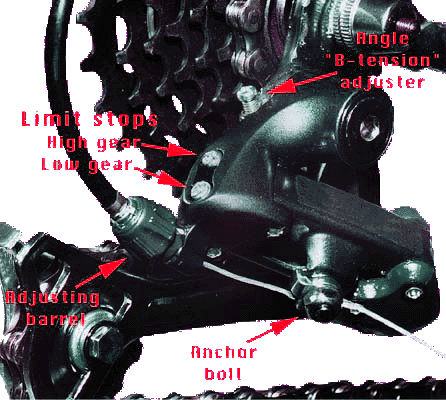
Everything You Wanted to Know
About Shifting Your Bicycle's Gears,
But Were Afraid to Ask...
Understanding Your Gears
Multi-speed gears allow you to climb hills comfortably that might force you to stand up and "pump" or even get off and push if you were riding a one-speed. They also allow you to go faster downhill or with the wind at your back.
Cadence
Every cyclist has an ideal "
cadence" (pedaling speed), and an ideal amount of resistance from the pedals. When you are pedaling at your ideal cadence, you are putting out the greatest amount of power that you are able to sustain efficiently. You select your cadence by shifting gears. The gear needed to allow your "ideal" cadence will depend on the slope of the road, the wind conditions, and your own condition at any given time.
High or Low?
"
Higher" gears put more resistance on the pedals. If you select a gear that is too high for the conditions, it will force you into a slower cadence.
Pedaling slower than your ideal cadence is wasteful of energy. You also run a higher risk of muscle strains and joint damage, particularly to the knees and hips.
"
Lower" gears make the pedals easy to turn, so it becomes easier to spin to a fast cadence.
Pedaling faster than your ideal cadence can allow you to generate an extra burst of speed, but you will tire yourself out too soon if you try to maintain an excessively fast cadence.
The Perfect Bicycle
If you had a perfect bicycle, with an infinite number of gears, you would always be pedaling at the same cadence, with the same amount of resistance to the pedals. Of course, the bike would go slower uphill, and faster downhill, but your legs would not know the difference.
Inexperienced cyclists often pedal at a cadence that is too slow, (too high a gear.) They sometimes think that this is better exercise, because they have to push harder on the pedals. This is an illusion.
Power lifting or swimming?
Consider two very different types of exercise: Power lifting vs. swimming. After you have lifted the 200 LB barbell half a dozen times, you go take a shower--high force, few repetitions. Swimming, on the other hand, involves very little resistance--you are only moving your hands and legs through water--but with many repetitions.
"Pushing" vs. "Spinning"
"Pushing" a
high gear at a slow cadence is like power lifting. It is good for building up muscle mass and bulking up your legs, but it does little for your heart or lungs, and you can hurt yourself if you overdo it.
"Spinning" a
lower gear at a rapid cadence is more like swimming. The rapid motion, with many repetitions makes the legs supple and flexible, it is highly aerobic, and the light pressure that goes with this style reduces wear and tear on the joints. With practice "spinning" becomes easier and more comfortable.
Securing your feet
Toe clips or "
clipless" pedals make it easier to spin effectively. They also enhance safety, because they keep your feet from slipping off of the pedals. They take a bit of getting used to, but experienced cyclists find them invaluable.
Nuts & Bolts of Derailer Gears
On a 10-speed bike, the front of the chain runs over one of 2 "
chainwheels" or front
sprockets attached to the pedal
cranks. The rear of the chain wraps around one of 5 sprockets attached to the hub of the rear wheel. The 2 chainwheels times 5 rear sprockets give 10 theoretically possible combinations. This set-up requires two separate gear shifting mechanisms or "
derailers", one for the front 2 and the other for the rear 5. This is as complicated as bicycle gearing gets.
A 27-speed bike is just the same, except that there are 3 chainwheels in front and 9 sprockets in back. There are still just two derailers, and two control levers.
The control on the left side shifts among the 2 or 3 front chainwheels; the one on the right shifts among the 5-9 rear sprockets.
How Derailers Work
A derailer leads the chain from one sprocket to another, while the chain is moving forward. The front derailer is a simple guide that moves the chain from side to side.
The rear derailer is a bit more complicated, because it also contains the spring and
pulleys that adjust the length of the chain as it moves to different-sized sprockets.
Always pedal forward
The chain can only move sideways while it is also moving forward. For this reason, you can only shift while you are pedaling forward.
The rear derailer shifts using the bottom of the chain loop, which is under light tension from the derailer's pulleys and springs.
The front derailer shifts using the upper part of the chain, the part that transmits power to the rear wheel. As a result, the front shifting will not work so well while you are pedaling very hard, or slowly, or both.
The rear derailer can usually shift under full load, but it is better for the chain to ease up a bit during the shift.
What's What
Try to visualize gear shifting in terms of where the chain is, rather than by rote memorization of positions of the shift controls.
The sprockets that are closer to the middle of the bike (small front, large rear) give the lower gears. The outer sprockets (large front, small rear) give higher gears.
Try to avoid the gears that make the chain cross over at an extreme angle. These "criss-cross" gears are bad for the chain and sprockets. Especially bad is to combine the inside (small) front sprocket with the outside (small) rear sprocket. This noisy, inefficient gear causes the chain to wear out prematurely.
I take no credit for the previous article, this was written by Sheldon Brown and
reposted from his website at
http://sheldonbrown.com/gears.html (An Excellent resource for Beginning Cyclists)


































